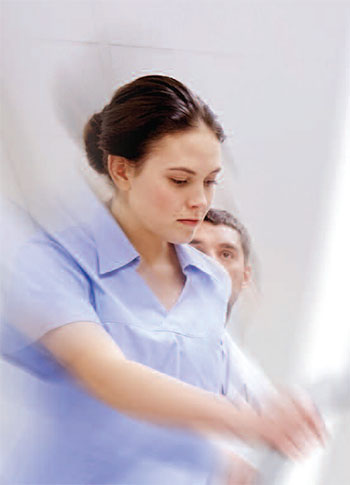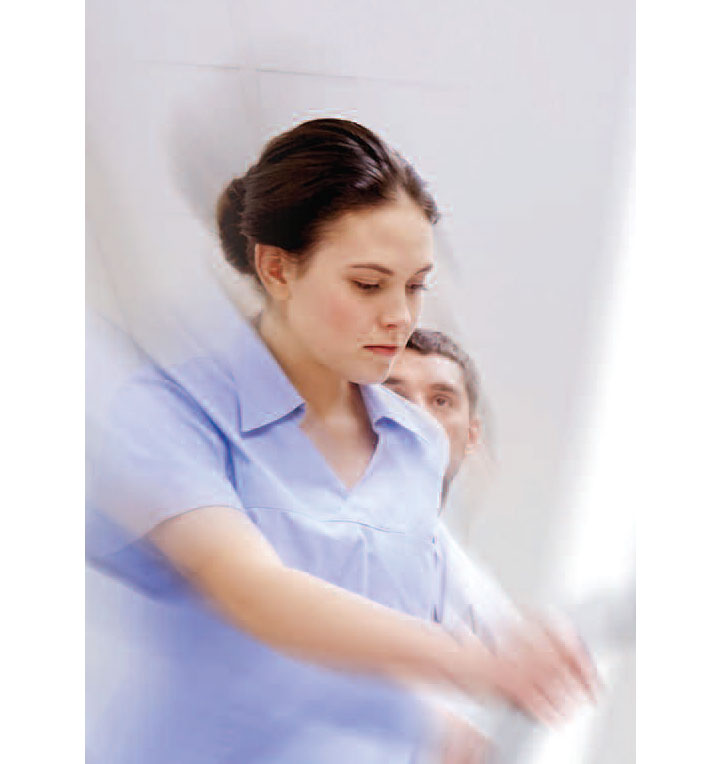Quick action reverses SVT and prevents a disastrous outcome.
Takeaways:
- Atrial fibrillation and atrial flutter are the most common subtypes of supraventricular tachycardia, which is relatively common in women.
- The treatment of choice for unstable patients is synchronized cardioversion.
- For stable patients, initial treatment is a vagal maneuver, such as the Valsalva maneuver or carotid massage.
- Pharmacologic treatment includes adenosine (preferred) or a calcium channel blocker or beta blocker.
By Cindy Ruiz, MS, APN-CNS, CCRN
Susan Brooks, age 75, arrives in the emergency department with new-onset chest pain, shortness of breath, and palpations. Her vital signs are stable, and she’s in normal sinus rhythm. A troponin test is negative, and a 12-lead electrocardiogram (ECG) and chest X-ray are unremarkable. Mrs. Brooks has a history of hypertension, myocardial infarction, and hyperlipidemia; her home medications include lisinopril, hydrochlorothiazide, and atorvastatin. She’s admitted for observation. That evening, she again experiences palpations and shortness of breath and pushes the call light.
History and assessment hints


On the scene
After summarizing your findings, the team administers
2 L oxygen by nasal cannula and begins infusing 0.9% normal saline solution. A 12-lead ECG shows that Mrs. Brooks is in a regular, narrow-QRS-complex supraventricular. tachycardia (SVT) at 170 bpm. You get the crash cart and connect Mrs. Brooks to the defibrillator for continuous ECG monitoring. Mrs. Brooks is stable, and the RRT team instructs her to perform a Valsalva maneuver by blowing forcefully into a straw. The maneuver is unsuccessful, so the physician orders adenosine 6 mg rapid I.V. push followed by a 20-mL bolus of saline. You tell Mrs. Brooks that she may experience a moment of claustrophobia, dyspnea, or chest discomfort. After 2 minutes with no change in her condition, a second dose of adenosine 12 mg rapid I.V. push is administered. Mrs. Brooks’ HR slows and returns to normal sinus rhythm at 80 bpm.
Outcome
Mrs. Brooks is transferred to the telemetry unit. A cardiology consult is ordered and a thyroid function test is performed. She’s discharged the next day with an event monitor and instructed to follow up with a cardiologist. Prophylactic drug therapy is an option for Mrs. Brooks; however, her age, symptom burden, and the frequency of the SVT occurrences should first be considered. Catheter ablation, which uses radiofrequency energy to selectively destroy abnormal conduction pathways, is another option.
Education and follow-up
SVT describes a group of arrhythmias whose fast rate—160 to 250 bpm—is produced from a pacemaker site above the atrioventricular (AV) node. Atrial fibrillation and atrial flutter are the most common subtypes of SVT, which is relatively common in women. Causes of SVT include abnormal levels of potassium, magnesium, and thyroid-stimulating hormone. Symptoms are usually acute in onset and include palpations, lightheadedness, chest pain, and dyspnea; some patients have no symptoms.
The treatment of choice for unstable patients is synchronized cardioversion. For stable patients, such as Mrs. Brooks, initial treatment is a vagal maneuver, such as the Valsalva maneuver or carotid massage. Use caution when performing carotid massage in older patients who may be at risk for carotid atheroembolism. The Valsalva maneuver increases intrathoracic pressure to stimulate the aortic and carotid baroreceptors, causing the vagus nerve to slow input into the AV node and halt the fast heart rate. The patient should be in a supine position and the maneuver attempted for 15 to 20 seconds.
If vagal maneuvers are unsuccessful, medication is the next step. Pharmacologic treatment includes adenosine or a calcium channel blocker or beta blocker. Adenosine is preferred because of its lower incidence of hypotension and extremely short half-life (10 seconds), which means it should be given close to the I.V. site and by rapid push. Adenosine is highly effective at causing a temporary complete AV node block. Adenosine may cause bronchospasm, so it shouldn’t be given to patients with asthma or chronic obstructive pulmonary disease.
If not reversed, SVT can lead to syncope, heart failure, myocardial infarction, or shock. You and the RRT team helped Mrs. Brooks avoid a disastrous outcome.
Cindy Ruiz is a critical care clinical nurse specialist at Northwest Community Healthcare in Arlington Heights, Illinois.
Selected references
Al-Khatib SM, Page RL. Acute treatment of patients with supraventricular tachycardia. JAMA Cardiol. 2016;1(4):483-5.
American Heart Association (AHA). Advanced Cardiovascular Life Support: Provider Manual. Chicago: AHA; 2016.
Hals G, McCoy C. Supraventricular tachycardia: A review for the practicing emergency physician. Relias (Formerly AHC Media). June 15, 2015.
Sohinki D, Obel OA. Current trends in supraventricular tachycardia management. Ochsner J. 2014;14(4):586-95.
Swift J. Assessment and treatment of patients with acute tachyarrhythmia. Nurs Stand. 2013;28(5):50-9.
ant3-Rapid Response-216a



















1 Comment.
Nice article.
I believe Chest pain,Dizziness or lightheadedness and Heart palpitations are main symptoms of SVT in patient.